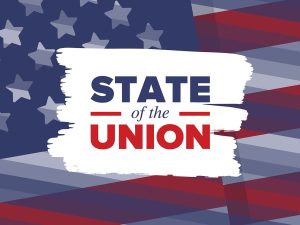


President George Washington gave the first State of the Union address to the nation on January 8, 1790, in Federal Hall in New York City. Last night, President Trump continued that tradition speaking from the well of the House of Representatives with a speech that lasted 78 minutes.
Clearly, the Democratic Party majority didn’t want him there. The speech, like all State of the Union speeches, was heavily choreographed and crafted. There is no Constitutional requirement that the State of the Union be delivered in person by the president. What was once a solemn but functional exchange between the branches of government has become more about political theater than it is about governing.
Some may wonder why every Congress and Administration continue the charade? The answer is — as you might guess — political.
The Super Bowl of Earned Media
The State of the Union is a unique opportunity for the president to speak to millions of viewers, unfiltered by the news media or partisan interpretations from the left and the right. Commanding the attention of millions of people for one hour and 18 minutes unabated is otherwise a nearly impossible feat and cost–prohibitive for most candidates. The speech, which every news and broadcast channel carries, gives any president a massive opportunity, especially in an election year.
To a lesser extent, the opposition party enjoys a similar benefit in the form of their “Response to the State of the Union” broadcast immediately following the president’s speech. This response offers the party out of power access to a smaller, but still massively concentrated audience, normally out of their reach. As such, it is equally calculated and choreographed with the right profiled speaker and poll-tested language, laying out the priorities of the opposition party rather than responding directly to the president.
Image Management
Because the State of the Union amounts to a one-way, closely watched conversation that allows the president to present the best interpretation of his/her track record and vision for the future with uninterrupted clarity, presidents typically see a post–State of the Union boost. In 2019, a CNN poll found that 59-percent of viewers had a positive reaction to the address. Today, CBS News reported that the initial response from the speech found 97-percent of Republicans viewed the speech favorably, but more critically, 30-percent of Democrats and 82-percent of independents did as well. Whether presidents are facing a tight election or a tough legislative session ahead, any positive bump among independent and undecided voters represents a significant boost to their party’s agenda.
Speaking Directly to Targeted Audiences
From NASCAR dads to soccer moms or blue-collar voters and minority voters, every president is propelled to power by certain voting blocs. In the State of the Union, presidents seek to hold their base of support and expand it to other key groups. Administrations often use special guests that speak directly to the concerns, issues, and aspirations to both the tried-and-true voting blocs and the ones they would like to make closer inroads with before the next election.
President Trump demonstrated this last night by seizing the opportunity to present the human faces of his agenda. With guests ranging from an African American student seeking a better school to returning members of the military and paying homage to a member of the famed Tuskegee Airmen, Trump reached out to a broad cross–section of America for maximum electoral impact.
Imagery
Watchers of the State of the Union speech might recognize that camera coverage routinely cuts a way to pan the Congressional chamber. Audience participation at the State of the Union is its own form of political communication. The imagery is filled with subtext that pundits in the mediate duly note and pontificate upon for days on end. This empowers both parties to either deliver a point or emphasize something the president has said. So, standing or sitting, both sides are speaking to the American public. However, last night was unique in that Speaker Nancy Pelosi’s animated destruction of a copy of the speech presented to her by Trump stole the show and will be the lasting image that defines the Democrats’ response.
State of the Union speeches might not serve the direct functions of the past, but they continue to play a critical role in the governance of our nation. In a communications environment filled with fractionalized affinity media, tech platforms, and editorial punditry, these speeches can be rare moments of focus and clarity that can educate the electorate and shape the opinions that ultimately decide the future course of our nation.

Let TDS work with you to pinpoint your specific needs and help you develop a comprehensive, integrated public affairs solution to help you win.